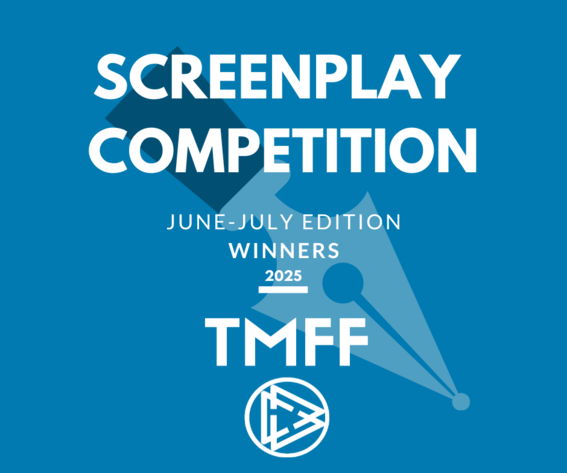As we transition into the days of autumn, we’re excited to spotlight the haunting and evocative short film ‘Baobhan Sith‘, our FILM OF THE MONTH winner for July 2024. This ten-minute piece, set in the grimy yet atmospheric streets of 1970s Glasgow, delves deep into the psyche of its protagonist, exploring themes of trauma, art, and madness. We recently had the pleasure of speaking with the film’s talented writer and director, Hayley Louise McGuire, to get some insights into the creation of this compelling story.
Congratulations, Hayley, on the success of ‘Baobhan Sith’! How has the film been received at festivals so far?
HLM: Generally, Baobhan Sith has done really well and we’re delighted with its reception so far. I will say having released it after being so close to the material for so long is strange. It’s bizarre to have it loose in the wild now, especially as it is such a personal passion project, but it’s also incredibly gratifying and exciting to share. The film was the result of a major joint effort between cast & crew who gave it their all and we’re thrilled to see our excellent team’s hard work celebrated. It’s also been really validating hearing the various interpretations of the film’s message and the reaction from critics and audiences alike has been better than we could have have imagined!
The story you’ve crafted is so intense and personal. What inspired you to tell it?
HLM: I feel like we all pour something of ourselves into our writing somehow and as the film suggests, “we all have our demons” so in a sense, I was sort of offering my perspective on that. I drew on my own experiences in various ways and dug into my passion for history and Scottish culture by exploring this issue that’s extremely important to me. It kind of turned into a manifestation of myself and my family’s collective demons, particularly inspired by the childhood memories of a very close family member. Each of us has a vampire in our life, draining us of our vitality and everyone experiences familial discord one way or another right? So this film is simply my own take on that.
The film feels deeply intimate, centering on Matthew’s internal struggles, particularly his complex relationship with his late mother. How did you craft this emotionally charged dynamic while maintaining a strong sense of dramatic tension throughout the story?
HLM: Honestly, half the battle was casting. We knew the actors would have a rather large weight to carry, as it’s quite a layered, emotionally demanding script, so we were relying a fair bit on exceptional actors with strong chemistry to bring it to life. Finding the right characters was crucial but luckily, we discovered our fabulous lead cast! They completely blew us away and I just saw my characters alive in them. Early on, we discussed the meaning behind the story, so they had a strong sense of what we wanted to achieve. Once on set, it was more about them fully inhabiting the world and letting them sit with that feeling. I had total trust in the cast, so I wanted to allow them plenty of room to experiment. The results were so effective! For the more emotionally charged scenes it was often a case of setting up and letting it roll, capturing all the subtleties of their performance. The rest was all in the visuals, sound design, production design and music. The entire team poured so much attention to detail and care into crafting the world. Everything you see and hear in Baobhan Sith means something
The editing in “Baobhan Sith” plays a crucial role in amplifying the film’s haunting atmosphere. How did you collaborate with the editor to create this chilling effect?
HLM: My connection with my editor was not the typical relationship you would expect to see between director and editor. As we were a relatively small production and are a brand new independent company, many jobs tend to fall to myself and my business partner, which was the case in this edit. It gave us a great advantage and further creative control. Jayme Bartlett, my wonderful cinematographer, edited the majority of the film and was involved with the project from its infancy as we developed Baobhan Sith together. Naturally, she had an excellent grasp of the film. Our process is quite unique in that way, as even in pre-production the writing was informed by conversations we had regarding the visuals. We knew exactly the film we set out to make, and of course, Jayme’s cinematographer eye greatly enhanced the final cut!
Reece Montague, the film’s lead actor, does an incredible job portraying Matthew. Was this your first time working with him, and how was the experience?
HLM: I had never met Reece before, but he came in to audition and just had an edge. I thought he was wonderful. His presence and attitude was perfect for the complexity I wanted to capture with Matthew’s character. Working with him was an absolute joy and I would jump at the chance to collaborate again. Not only is he a phenomenally talented and intelligent actor, but he is a genuinely lovely person. He effortlessly breathed life into the story and dropped into an intensely demanding role with ease. He just amazed us all and had an inexplicable understanding of the material before we even fully discussed it, which shows in his performance. He made my job as director a hell of a lot easier and was very respectful of his character’s importance to me. This certainly won’t be the last you’ll hear of him. An actor like Reece is definitely due some serious recognition!
The setting of 1970s Glasgow adds a unique atmosphere to the film. What made you choose this specific time and place for the story?
HLM: I tend to obsess over uncovering forgotten stories from the past, so I’m often drawn in by research of historical events I find compelling. This is how I came across the legend of the Gorbals Vampire, a case of mass hysteria in a notoriously deprived area of Glasgow during the 1950s. Reading about this peculiar phenomenon led me to consider how this fictional creature was likely the poor children of the area’s embodiment of their individual frustrations and fears, influenced by the poverty, lack of affection, repression, violence and despair surrounding them. I then invented Matthew as a symbol of this, as if he were one of those children, basing his journey on a true story that is very close to my heart. I wanted to explore how his past tainted his adulthood and how his vampire, his mother, cast a cloud over his life. This naturally led to the gritter setting of 70s Glasgow for Matthew to reflect on his upbringing in a harsher and darker city than the one we know today, a tribute to the film’s inspiration and the perfect place for him to slay his vampire
The title “Baobhan Sith” is quite intriguing. Can you tell us more about its significance and how it ties into the film’s themes?
HLM: I was eager to include several folkloric elements in the film and intended it to be a subtle tribute to Scottish mythology. So when we discovered a mythical figure with an intriguing Gaelic name known as the Baobhan Sith, we found its meaning tied in nicely with the film’s themes and perfectly represented our villain. The Baobhan Sith is an enigmatic creature with several different myths attached to it, one being that it is a female vampire that roams the highlands in search of men’s blood. We ended up adopting this name for Matthew’s monster of a mother, with the Baobhan Sith that terrorised his childhood dreams, becoming a nightmarish muse of his own invention in his adult artwork. Originally, we were planning to involve many more Gaelic elements in the film and with its surrealist style, we felt it would be a fitting title. I love the mystery the name conjures up and the layered backstory of the creature itself. It really expresses the mother’s graceful and unnerving power
Are there any particular challenges you faced during the writing or production of “Baobhan Sith”?
HLM: If you have a spare fortnight I could elaborate on the many logistical issues we encountered, however besides the usual problems you would expect from a short film, I feel like our main worries centred around the ambitious approach to the project. This was our first professional short film as a company and was a larger undertaking than anything we’ve done before, so we felt there was a lot riding on it. However, we were incredibly lucky in many ways. For example, for our first time working with children, things could not have gone better and our young performers were so enthusiastic, committed and patient, not to mention utterly charming and naturally talented. Being a lower budget short film obviously comes with a number of difficulties but once again, our outstanding crew and supporters really pulled through and handled it all spectacularly. From crafting a period accurate set complete with tiny details to making props such as actual engraved tombstones and beautiful paintings, to just crew members going out of their way to assist with transport, catering and set construction, I really can’t rave enough about the lengths people went to helping us make this film a reality. We are so grateful for it and it definitely paid off.
What projects are you working on next, and can we expect to see more of this dark, psychological storytelling in the future?
HLM: It’s only natural for me to lean towards the darkness. I’m constantly trying to recapture a sense of childlike imagination and I think my pull to the shadows is a reflection of that, since I was a weird child and have always been obsessed with things like the paranormal and mysteries. It has unconsciously become a defining part of how I write and although I intend to further explore various genres, telling a variety of stories, I’m hopeful there’s a common thread throughout. Though I’m still developing this voice, I’m certain my penchant for the dark will only grow and absolutely seep into future projects (much to the dismay of my business partner & cinematographer, who isn’t the biggest fan of shooting these creepy visuals) We are currently in the very early stages of development on an exciting new project that will be another step up for Blade & Bow. Again drawing on Scotland’s rich historical past, and exploring an entirely different era, this period drama is yet another immensely personal story I feel compelled to share. As sort of time travelling filmmakers, we’re so looking forward to delving deeper into history with this next film that we are very hopeful of making progress on in the near future. The recognition we have received from TMFF has both inspired us and been so reassuring that we are moving in the right direction! We are so thankful for this, as being chosen as film of the month for July was really special to us and is much appreciated









Leave a reply